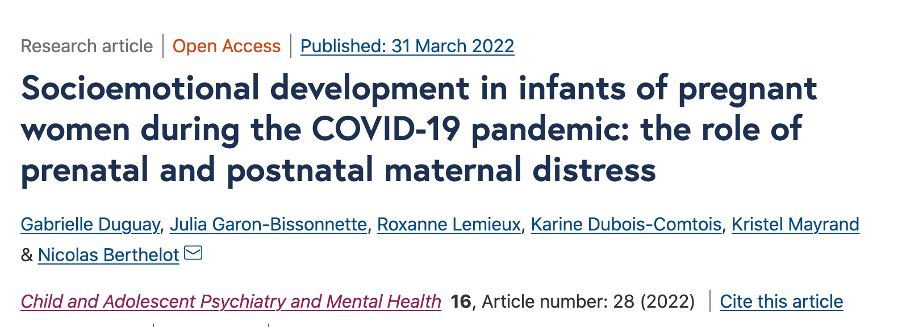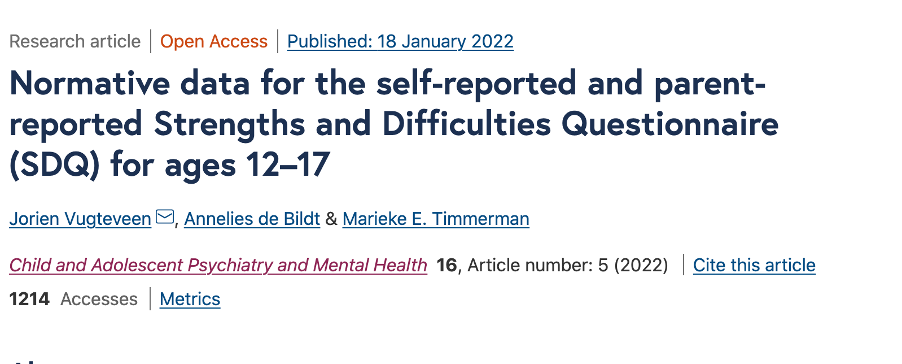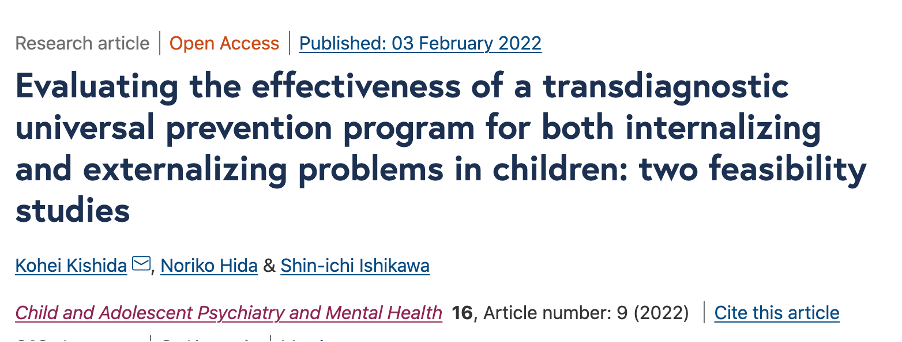CAPMH Corner (Updated Jun 2022)
By: Lakshmi Sravanti, India | Associate Editor, CAPMH
Child and Adolescent Psychiatry and Mental Health (CAPMH) is the official IACAPAP Journal. The "CAPMH Corner" of the current issue summarizes the following three recently published studies– socioemotional development in infants of pregnant women during the COVID-19 pandemic: the role of prenatal and postnatal maternal distress (Duguay et al., 2022), normative data for the self-reported and parent-reported Strengths and Difficulties Questionnaire (SDQ) for ages 12-17 (Vugteveen, de Bildt, and Timmerman, 2022), and evaluating the effectiveness of a transdiagnostic universal prevention program for both internalizing and externalizing problems in children: two feasibility studies (Kishida, Hida, and Ishikawa, 2022).
Duguay et al., (2022) note the adverse impact of the COVID-19 pandemic on pregnant women and highlight the negative influence of prenatal and postnatal distress on early child development. They evaluate the effects of general maternal distress on early infant development during the COVID-19 pandemic through their study.
The team recruited pregnant women who are older than 18yrs from online social media platforms during the first COVID-19 mandatory lockdown in the Province of Quebec, Canada (T1, from 2-13 April 2020). At the second assessment (T2, from 13 July – 19 February 2021), participants who accepted to be re-contacted with an infant between 6-13 weeks were invited to participate. The studied a sample of 468 women and their infants. The authors operationalized maternal distress using the French versions of the Kessler Psychological Distress Scale (K10) and of the Edinburgh Postnatal Depression Scale (EPDS). They assessed infants' socioemotional development between 6 and 13 weeks postpartum using the 2-month version of the Ages and Stages Questionnaire: Social-Emotional, second edition (ASQ: SE-2) and conducted Pearson correlations, ANCOVA and structural equation modeling (SEM) analyses with MPlus.
Authors report that prenatal and postnatal maternal distress account for 13.7% of the variance in infant socioemotional development. As per their research, maternal prenatal symptoms are indirectly and significantly associated with developmental delays via maternal postnatal symptoms, b = 0.084, 95% CI [0.038, 0.131], and only postnatal symptoms have a direct and significant effect on developmental delays, OR = 1.14, 95% CI [1.064, 1.225]. They conduct a post hoc analysis (Bonferroni correction) that shows that only mothers who reached a clinical level of distress at both time points reported poorer infant development (n = 62, M = 28.205, SE = 1.894) than mothers without any distress (n = 257, M = 21.116, SE = 0.929), mean difference = − 7.089, p = 0.005, SE = − 0.475. Thus, they observe that only mothers with persisting distress over pregnancy and the postnatal period reported significantly poorer infant development, and not mothers who reached clinical levels of distress solely at the postnatal assessment.
The authors note that symptoms of anxiety and depression are expected when facing challenging life circumstances such as the COVID-19 pandemic. They suggest that pregnant women should consider such symptoms as a warning signal and not worry overly about their consequences for their child. They acknowledge that they lack data over the whole course of pregnancy or about breastfeeding and that they cannot establish causal links as it is a correlational design. They recommend future research to study specific impacts of different COVID-19 stressors (financial, public health, loss of social support) on perinatal mental health and its link with infant development.
Vugteveen et al., (2022) set out to provide joint norms and gender-specific norms per year of age for the Dutch Strengths and Difficulties Questionnaire [(SDQ), self-reported and parent-reported versions] for use among 12- to 17-year-old adolescents. The SDQ is widely used to screen for psychosocial problems among adolescents. SDQ has multiple language versions. Authors state that the occurrence of psychosocial problems is related to age and gender, however, joint norms and gender-specific norms per year of age were not established for any of the language versions of SDQ. They further highlight that in the Netherlands, SDQ scale scores are analysed using old norms that were established based on a British sample that are neither age-specific nor gender-specific and that the Dutch norms for its parent-reported version were only recently established. In addition, the SDQ scale scores provided by Dutch adolescents and their parents result in much lower detection rates than the intended 10% of the most extremely scoring adolescents.
The team collects SDQ data in three waves at schools for secondary education: (1) in 2009/2010 data (n = 519), (2) in 2011-2013 (n = 331), and (3) in 2016/2017 (n = 443). They exclude 246 of the 1293 adolescents and parents as some socio-demographic information was missing. The remaining 1047 adolescents and parents form the norm groups for the self-reported (n = 993) and the parent-reported (n = 736) versions. The authors calculate gender-specific norms and joint norms for 8 scales (1 strengths scale, 4 difficulties scales, 1 total difficulties scale, 1 externalizing difficulties scale, 1 internalizing difficulties scale but not for the impact scale that was later added to the SDQ) per SDQ version (adolescent, parent). They estimate population distribution by using the Box-Cox power exponential (BCPE) distribution and determine norms through regression-based norming using generalized additive models for location, scale, and shape (GAMLSS) and perform reliability analyses at the item level.
The team establishes joint ‘abnormal’ cutoffs to identify a maximum of 10% of all adolescents, resulting in the identification of relatively more male than female adolescents as scoring ‘abnormal’ on scales measuring externalizing problems (self-reported and parent-reported SDQ versions), and of relatively more female than male adolescents as scoring ‘abnormal’ on scales measuring internalizing problems (self-reported SDQ version). They present norms for 15-year-old male and female adolescents for all eight scales of the parent-reported SDQ version, as an example of what the norms look like. In this age group (for the parent-reported version), the norms show higher occurrence rates of hyperactivity/inattention and externalizing problems for male than for female adolescents. Consequently, the cutoff values for classifying scores on these scale as ‘borderline’ or ‘abnormal’ are higher for males than for females. For example, they consider hyperactivity scale scores ≥ 5 as ‘abnormal’ for females, whereas ≥ 7 as abnormal for males scores.
The authors note that the norms show the presence of age- and gender-effects in the reported extent to which problems occur. They reinstate that they provide gender-specific norms in addition to the joint norms, therewith facilitating the comparison of an adolescent’s scores to different reference groups. They advise a reconsideration of using the British norms in Dutch (mental) healthcare practice and presume their newly established norms to be more useful for interpreting Dutch adolescents’ scores because they are a) fairly recent (norms can become outdated), (b) age-specific, (c) available for the self-reported and the parent-reported SDQ versions, (d) established using regression-based (i.e., continuous) norming, and (e) based on decent sample sizes, with representativity issues (regarding gender and ethnic background) corrected for.
Kishida et al., (2022) highlight the advantages of universal approaches to prevention and the usefulness of transdiagnostic preventive interventions. The Universal Unified Prevention Program for Diverse Disorders (Up2-D2) is a teacher-delivered cognitive-behavioral and positive psychological intervention, developed as a transdiagnostic preventive intervention program that can address both internalizing and externalizing problems in children and adolescents (Ishikawa et al., 2019). They mention that previous feasibility trials demonstrated that the Up2-D2 can be effective for decreasing general difficulties not only in general samples but also in high-risk or subclinical samples. However, the impact of the types of teacher training and degree of ongoing supervision on the effectiveness of the Up2-D2 was not investigated. Through the present study, they examine the effectiveness of the Up2-D2 for both internalizing and externalizing problems in children aged 9–11 years, implementing two feasibility studies – one study includes on-site teacher training and ongoing supervision, and the other includes only self-learning DVD materials in place of training and supervision.
The team executes distinct methodologies for Study 1 (elementary school A) and Study 2 (elementary school B). They provide 1.5 h of on-site teacher training for learning rationales for interventions, how to run the program, and ongoing supervision to teachers in Study 1. However, they supply only self-learning DVD materials to teachers in Study 2. Two teachers implement the program about once every two weeks from September 2020 to February 2021 in school A and three teachers implement the program about once every two weeks from September 2020 to March 2021 in school B. The Up2-D2 program consists of 12 sessions: psychoeducation about emotion (session 1), behavioral activation (session 2), social skills training (sessions 3 and 4), relaxation (session 5), strength work (session 6), cognitive restructuring (sessions 7 and 8), exposure (sessions 9 and 10), problem-solving (session 11), and review and conclusion (session 12). Each session lasts for 45–50 min. The authors assess the subjects using the Japanese version of the self-reported Strengths and Difficulties Questionnaire (SDQ), short version of the Spence Children’s Anxiety Scale (Short CAS), short version of the Depression self‑rating scale for children (DSRS-C), Anger scale for children and adolescents (ASCA). They conduct mixed model analyses with time (pre-assessment and post-assessment) as a fixed effect and both individual and class as random effects. They calculate the effect sizes (Hedges’ g) and 95% confidence intervals (CIs).
Results for the total samples reveal that general difficulties decreased in Study 1 (g = − 0.20), but not in Study 2 (g = 0.15). Additional analyses of the subclinical samples reveal that general difficulties, internalizing problems, and externalizing problems decreased in Study 1 (g = − 0.79; g = − 0.52; g = − 0.60, respectively), whereas general difficulties and internalizing problems decreased in Study 2 (g = − 0.69; g = − 0.55). The authors conclude that interactive training and continuous supervision is essential to make the most of universal preventive interventions in schools. They acknowledge the lack of a control group and follow-up measurements, the use of only self-reported measures and the lack of assessments of teachers (teacher motivation, teachers’ mental health literacy, and fidelity of intervention delivered by teachers were not measured) as limitations of their study. They also mention that the data were obtained from only Japanese samples and are unsure if the data were representative of the population of Japanese children in general or not. They suggest future research to examine potential moderators, including age and/or grade, in terms of universal preventive programs in schools and to measure mediation variables to examine why this program might be effective for generalized difficulties.
References
Duguay, G., Garon-Bissonnette, J., Lemieux, R. et al. Socioemotional development in infants of pregnant women during the COVID-19 pandemic: the role of prenatal and postnatal maternal distress. Child Adolesc Psychiatry Ment Health 16, 28 (2022). https://doi.org/10.1186/s13034-022-00458-x
Ishikawa, Si., Kishida, K., Oka, T. et al. Developing the universal unified prevention program for diverse disorders for school-aged children. Child Adolesc Psychiatry Ment Health 13, 44 (2019). https://doi.org/10.1186/s13034-019-0303-2
Kishida, K., Hida, N. & Ishikawa, Si. Evaluating the effectiveness of a transdiagnostic universal prevention program for both internalizing and externalizing problems in children: two feasibility studies. Child Adolesc Psychiatry Ment Health 16, 9 (2022). https://doi.org/10.1186/s13034-022-00445-2
Vugteveen, J., de Bildt, A. & Timmerman, M.E. Normative data for the self-reported and parent-reported Strengths and Difficulties Questionnaire (SDQ) for ages 12–17. Child Adolesc Psychiatry Ment Health 16, 5 (2022). https://doi.org/10.1186/s13034-021-00437-8




